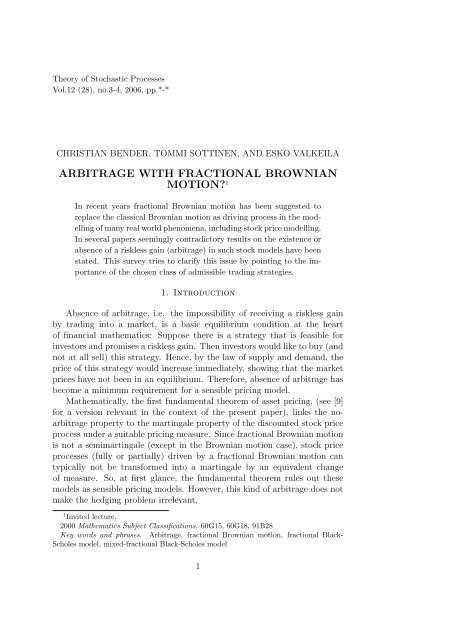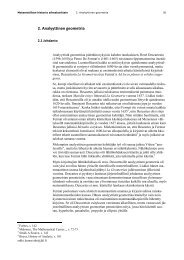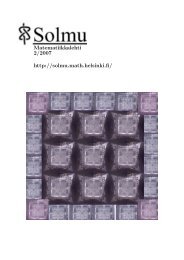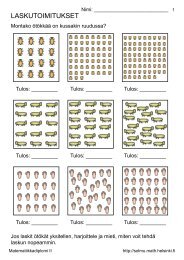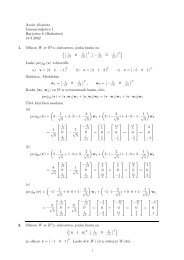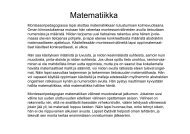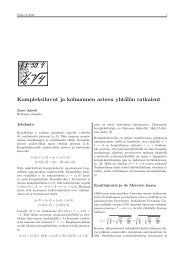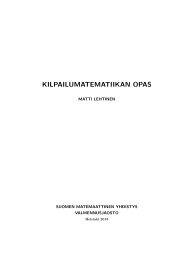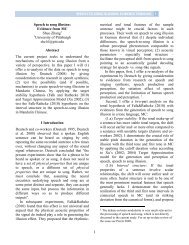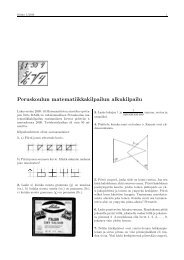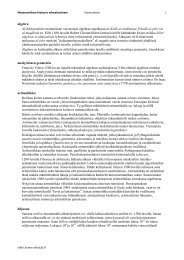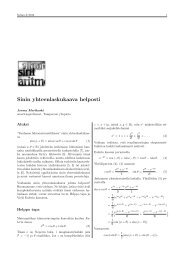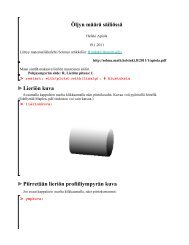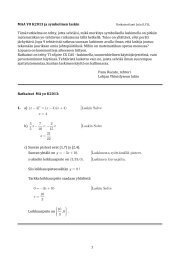ARBITRAGE WITH FRACTIONAL BROWNIAN MOTION?1 - Helsinki.fi
ARBITRAGE WITH FRACTIONAL BROWNIAN MOTION?1 - Helsinki.fi
ARBITRAGE WITH FRACTIONAL BROWNIAN MOTION?1 - Helsinki.fi
Create successful ePaper yourself
Turn your PDF publications into a flip-book with our unique Google optimized e-Paper software.
Theory of Stochastic Processes<br />
Vol.12 (28), no.3-4, 2006, pp.*-*<br />
CHRISTIAN BENDER, TOMMI SOTTINEN, AND ESKO VALKEILA<br />
<strong>ARBITRAGE</strong> <strong>WITH</strong> <strong>FRACTIONAL</strong> <strong>BROWNIAN</strong><br />
<strong>MOTION</strong>? 1<br />
In recent years fractional Brownian motion has been suggested to<br />
replace the classical Brownian motion as driving process in the modelling<br />
of many real world phenomena, including stock price modelling.<br />
In several papers seemingly contradictory results on the existence or<br />
absence of a riskless gain (arbitrage) in such stock models have been<br />
stated. This survey tries to clarify this issue by pointing to the importance<br />
of the chosen class of admissible trading strategies.<br />
1. Introduction<br />
Absence of arbitrage, i.e. the impossibility of receiving a riskless gain<br />
by trading into a market, is a basic equilibrium condition at the heart<br />
of <strong>fi</strong>nancial mathematics: Suppose there is a strategy that is feasible for<br />
investors and promises a riskless gain. Then investors would like to buy (and<br />
not at all sell) this strategy. Hence, by the law of supply and demand, the<br />
price of this strategy would increase immediately, showing that the market<br />
prices have not been in an equilibrium. Therefore, absence of arbitrage has<br />
become a minimum requirement for a sensible pricing model.<br />
Mathematically, the <strong>fi</strong>rst fundamental theorem of asset pricing, (see [9]<br />
for a version relevant in the context of the present paper), links the noarbitrage<br />
property to the martingale property of the discounted stock price<br />
process under a suitable pricing measure. Since fractional Brownian motion<br />
is not a semimartingale (except in the Brownian motion case), stock price<br />
processes (fully or partially) driven by a fractional Brownian motion can<br />
typically not be transformed into a martingale by an equivalent change<br />
of measure. So, at <strong>fi</strong>rst glance, the fundamental theorem rules out these<br />
models as sensible pricing models. However, this kind of arbitrage does not<br />
make the hedging problem irrelevant.<br />
1 Invited lecture.<br />
2000 Mathematics Subject Classi<strong>fi</strong>cations. 60G15, 60G18, 91B28<br />
Key words and phrases. Arbitrage, fractional Brownian motion, fractional Black-<br />
Scholes model, mixed-fractional Black-Scholes model<br />
1
2 CHRISTIAN BENDER, TOMMI SOTTINEN, AND ESKO VALKEILA<br />
Note that existence of an arbitrage crucially depends on the class of<br />
investment strategies that is at the investor’s disposal. The fundamental<br />
theorem presupposes a class of admissible strategies which is – in some sense<br />
– as big as possible from a mathematical point of view. Apart from being<br />
self-<strong>fi</strong>nancing and a condition excluding doubling strategies, any predictable<br />
and integrable process (w.r.t. the stock price process) is admissible.<br />
In the other extreme, it is of course always possible to construct a class<br />
of strategies that is small enough to exclude arbitrage. (For instance one<br />
can forbid all trading.) So the problem to be discussed can be posed as: Is<br />
it possible to construct a class of economically meaningful strategies, that<br />
does not contain arbitrage and is at the same time suf<strong>fi</strong>ciently rich to be<br />
interesting from the perspective of pricing? By ‘interesting from the perspective<br />
of pricing’ we mean that practically relevant options can be priced<br />
via (approximative) replication arguments within the class of strategies.<br />
The main purpose of this paper is to discuss several results on existence<br />
or absence of arbitrage in models driven by a fractional Brownian motion<br />
for different classes of strategies in the light of the above criterion. After<br />
explaining the self-<strong>fi</strong>nancing condition in Section 2 we consider models<br />
purely driven by a fractional Brownian motion and different subclasses of<br />
self-<strong>fi</strong>nancing strategies in Section 3. In Section 4 we discuss the notion of<br />
Wick-self-<strong>fi</strong>nancing portfolios. Models simultaneously driven by a Brownian<br />
motion and a fractional Brownian motion are treated in Section 5. Finally,<br />
Section 6 summarizes our <strong>fi</strong>ndings.<br />
2. Self-<strong>fi</strong>nancing portfolios<br />
Throughout this paper a discounted market model is a 6-tuple<br />
M = (Ω, F, {F t } 0≤t≤T , P, S, A),<br />
where (Ω, F, {F t } 0≤t≤T , P ) is a <strong>fi</strong>ltered probability space, S = (S t ) 0≤t≤T is<br />
an adapted stochastic process modelling discounted stock prices, and A is<br />
a set of admissible trading strategies. For simplicity we shall assume that<br />
the process S takes values in R and has continuous trajectories. Hence we<br />
consider a market with two tradable assets: the discounted stock S and a<br />
discounted money market account B t ≡ 1.<br />
A portfolio is a pair of adapted stochastic processes ϕ = (β t , γ t ). The<br />
processes β t and γ t denote the amount of money stored on the bank account<br />
at time t and number of stock shares held at time t respectively. Thus, the<br />
corresponding wealth process is given by<br />
V t (ϕ) = β t + γ t S t .<br />
De<strong>fi</strong>nition 1. (i) A portfolio ϕ is an arbitrage, if V 0 (ϕ) = 0, V T (ϕ) ≥ 0<br />
P -almost surely, and P (V T (ϕ) > 0) > 0.<br />
(ii) A market M is free of arbitrage, if no portfolio ϕ ∈ A is an arbitrage.
<strong>ARBITRAGE</strong> <strong>WITH</strong> FBM? 3<br />
Obviously, the notion of an arbitrage-free market crucially depends on<br />
the chosen class of admissible portfolios. A standard restriction is, that<br />
only self-<strong>fi</strong>nancing portfolios can be admissible: Suppose, under absence of<br />
transaction costs, the investor’s portfolio is constant between times t 1 and<br />
t 2 , and she rearranges her portfolio at time t 2 . Then her wealth immediately<br />
before rearranging is β t1 + γ t1 S t2 and her wealth immediately after<br />
rearranging is β t2 + γ t2 S t2 . Now ‘self-<strong>fi</strong>nancing’ means, by de<strong>fi</strong>nition, that<br />
these two values coincide, i.e. that neither money is added nor withdrawn<br />
when rearranging the portfolio. Note that, by elementary manipulations,<br />
this self-<strong>fi</strong>nancing condition is equivalent to<br />
V t2 (ϕ) = V t1 (ϕ) + γ t1 (S t2 − S t1 ).<br />
So, a natural extension of the self-<strong>fi</strong>nancing condition to a more general<br />
class of portfolios can be given in terms of the forward integral. We briefly<br />
review the pathwise approach due to Föllmer [13] and refer the reader to<br />
[16], [21], and [26] for different approaches.<br />
De<strong>fi</strong>nition 2. Suppose a sequence (π n ) of partitions of [0, T ] is given such<br />
that mesh(π n ) → 0. Then X is said to have a forward integral w.r.t. S, if<br />
lim<br />
∑<br />
n→∞<br />
t i ∈π n ;t i ≤t<br />
X ti−1 (S ti − S ti−1 ) =:<br />
∫ t<br />
0<br />
X u dS u<br />
exists P -almost surely for all 0 ≤ t ≤ T and de<strong>fi</strong>nes a continuous function<br />
in t on almost every path.<br />
For the remainder of the paper we will consider an appropriate sequence<br />
of partitions π n <strong>fi</strong>xed and suppress the dependence on π n in all de<strong>fi</strong>nitions<br />
below.<br />
De<strong>fi</strong>nition 3. A portfolio ϕ = (β t , γ t ) is said to be self-<strong>fi</strong>nancing, if γ t has<br />
a forward integral w.r.t. to S and, for all 0 ≤ t ≤ T ,<br />
V t (ϕ) = V 0 (ϕ) +<br />
∫ t<br />
0<br />
γ u dS u .<br />
We can now introduce some classes of admissible portfolios.<br />
De<strong>fi</strong>nition 4. (i) A portfolio ϕ t = (β t , γ t ) is simple, if there exists a <strong>fi</strong>nite<br />
number of non-decreasing stopping times τ 0 , . . . , τ K , such that the portfolio<br />
is constant on (τ k , τ k+1 ]. The set of simple and self-<strong>fi</strong>nancing portfolios is<br />
denoted A si .<br />
(ii) An ɛ-simple portfolio is a simple one such that τ k+1 − τ k > ɛ for all k.<br />
The set of ɛ-simple and self-<strong>fi</strong>nancing portfolios is denoted A ɛ,si .<br />
(iii) A self-<strong>fi</strong>nancing portfolio ϕ t = (β t , γ t ) is nds-admissible, if there is a<br />
constant a ≥ 0 such that for all 0 ≤ t ≤ T ,<br />
V t (ϕ) ≥ a<br />
P -almost-surely.
4 CHRISTIAN BENDER, TOMMI SOTTINEN, AND ESKO VALKEILA<br />
The set of nds-admissible portfolios is denoted A nds . Here nds stands for<br />
‘no doubling strategy’.<br />
As a direct consequence of the fundamental theorem of asset pricing (in<br />
the version of Delbaen and Schachermeyer [9]), we obtain:<br />
Theorem 1. If S is not a semimartingale, then there exists an approximative<br />
arbitrage in the class A si .<br />
Here, an approximative arbitrage is meant in the sense of a ‘free lunch<br />
with vanishing risk’. We refer the reader to [9] for the exact de<strong>fi</strong>nition<br />
of this notion. The previous theorem implies that one needs to restrict the<br />
class of self-<strong>fi</strong>nancing strategies, if one wants to consider non-semimartingale<br />
models, for instance the models (fully or partially) driven by a fractional<br />
Brownian motion that we consider in the following sections.<br />
3. Arbitrage in fractional Black-Scholes model<br />
Recall that fractional Brownian motion B H t with Hurst parameter 0 <<br />
H < 1 is a continuous centered Gaussian process with covariance structure<br />
E[B H t B H s ] = 1 2<br />
(<br />
t 2H + s 2H − |t − s| 2H) .<br />
We state some well known properties of the fractional Brownian motion:<br />
1. For H = 1/2 fractional Brownian motion is a classical Brownian motion.<br />
2. If H ≠ 1/2 fractional Brownian motion is not a semimartingale.<br />
3. If H > 1/2, fractional Brownian motion has zero pathwise quadratic<br />
variation along appropriate sequences of partitions, i.e. for all 0 ≤<br />
t ≤ T ,<br />
lim<br />
∑<br />
n→∞<br />
t i ∈π n ; t i ≤t<br />
|B H t i<br />
− B H t i−1<br />
| 2 =: 〈B H 〉 t = 0; P -almost surely.<br />
4. For H > 1/2 fractional Brownian motion has a long memory, in the<br />
sense that the covariance function<br />
ρ H (n) := Cov(B H k<br />
− B H k−1, B H k+n − B H k+n−1)<br />
satis<strong>fi</strong>es ∑ ∞<br />
n=1 |ρ H (n)| = ∞.<br />
From now on B H will always denote a fractional Brownian motion with<br />
H > 1/2. Since Itô’s formula carries over to the forward integral, with the<br />
quadratic variation interpreted in the above pathwise sense, (see [13]), we<br />
obtain<br />
∫ t<br />
f(Bt H ) = f(0) + f ′ (Bu H )dBu H ,<br />
0
<strong>ARBITRAGE</strong> <strong>WITH</strong> FBM? 5<br />
(including the existence of the forward integral). Hence, the pathwise fractional<br />
Black-Scholes model with parameters σ > 0 and µ ∈ R<br />
˜S H t = s 0 exp { σB H t + µt }<br />
satis<strong>fi</strong>es the pathwise SDE<br />
d ˜S H t = µ ˜S H t dt + σ ˜S H t dB H t .<br />
Note that the forward integral does not have zero expectation in general.<br />
Hence, we cannot interpret the second term in the SDE as an additive noise.<br />
A remedy is to consider the SDE in the Wick-Itô sense (see the next Section<br />
for the de<strong>fi</strong>nition of the Wick-Itô integral). Its solution<br />
S H t = s 0 exp { σB H t − 1/2σ 2 t 2H + µt }<br />
is called the Wick-fractional Black-Scholes model. It coincides with the<br />
classical Black-Scholes model for H = 1/2. Actually, the term −1/2σ 2 t 2H<br />
is a drift term that does not have any influence on the arbitrage issue. So<br />
we will consider the model S H only.<br />
Since fractional Brownian motion with H > 1/2 is not a semimartingale<br />
we conclude from Theorem 1 that there exists approximative arbitrage for<br />
St H in the class A si . The following example, essentially due to Shiryaev [23]<br />
and Dasgupta and Kallianpur [10], gives a simple explicit construction of<br />
an arbitrage in the class of nds-admissible strategies A nds . It only relies on<br />
the fact that St H inherits the zero quadratic variation property from B H .<br />
Example 1. Let g be continuously differentiable nonnegative function<br />
satisfying g(0) = 0 and g(x 0 ) > 0 for some x 0 ∈ R. De<strong>fi</strong>ne ϕ = (β t , γ t ) with<br />
Then,<br />
β t = g(S H t − s 0 ) − g ′ (S H t − s 0 )S H t , γ t = g ′ (S H t − s 0 ).<br />
V t (ϕ) = g(S H t − s 0 ) − g ′ (S H t − s 0 )S H t + g ′ (S H t − s 0 )S H t = g(S H t − s 0 ).<br />
Consequently, ϕ is an arbitrage that is bounded from below by 0. To show<br />
that ϕ ∈ A nds , the self-<strong>fi</strong>nancing condition must be veri<strong>fi</strong>ed. However, by<br />
Itô’s formula applied to the zero quadratic variation process St<br />
H −s 0 we get,<br />
V t (ϕ) = g(S H t − s 0 ) =<br />
∫ t<br />
0<br />
g ′ (S H t − s 0 )dS H u =<br />
∫ t<br />
0<br />
γ u dS H u .<br />
We now consider the function g(x) := (x) + := max{x, 0}, and approximate<br />
it by a sequence of continuously differentiable nonnegative functions<br />
g m (x) satisfying g m (0) = 0. From the previous example we obtain<br />
a sequence of nds-admissible arbitrages ϕ m such that V 0 (ϕ m ) = 0 and
6 CHRISTIAN BENDER, TOMMI SOTTINEN, AND ESKO VALKEILA<br />
V T (ϕ m ) = g m (ST H − s 0 ) ≈ (ST H − s 0 ) + for large m. Hence, these arbitrages<br />
constitute, for large m, approximate hedges for an at-the money European<br />
call option with initial capital 0.<br />
We close this section by a remark summarizing some interesting results<br />
on existence and absence of arbitrage for different classes of portfolios.<br />
Remark. (i) Cheridito proves in [8] that the fractional Black-Scholes model<br />
is free of arbitrage with the class A ɛ,si of ɛ-simple strategies for every ɛ > 0.<br />
On the other hand, the cheapest super-replicating portfolio for a European<br />
call option in the class A ɛ,si is to buy one share of the stock at time 0 and<br />
to hold it until time T . Hence, only a trivial price bound for European call<br />
options can be obtained that way.<br />
(ii) A portfolio is called almost simple, if there is a sequence of nondecreasing<br />
stopping times (τ k ) k∈N such that P (τ k = T in<strong>fi</strong>nitely often) = 1 and<br />
the portfolio is constant on (τ k , τ k+1 ]. This means that the number of rearranging<br />
times is <strong>fi</strong>nite on almost every path, but not necessarily bounded<br />
as function on Ω. Existence of a self-<strong>fi</strong>nancing almost simple arbitrage has<br />
been shown by Rogers [20], making use of the history of a fractional Brownian<br />
motion starting at −∞, and subsequently by Cheridito [8], taking only<br />
the history starting from 0 into account. Both constructions rely on the<br />
long memory property of the fractional Brownian motion.<br />
(iii) A very intuitive construction of an arbitrage in fractional Cox-Ross-<br />
Rubinstein models, exploiting the memory of a binary version of a fractional<br />
Brownian motion, can be found in [24] and [4]. In [24] the discrete<br />
approximation of the fractional Black-Scholes model is based on ordinary<br />
products, in [4] on discrete Wick products.<br />
(iv) Under proportional transaction costs, absence of arbitrage for the fractional<br />
Black-Scholes models is proved in [14]. The introduction of proportional<br />
transaction costs requires, however, that only processes of bounded<br />
variation can be considered as portfolios.<br />
We conclude that there seems to be no subclass of self-<strong>fi</strong>nancing strategies<br />
that is suf<strong>fi</strong>ciently small to be free of arbitrage and, at the same time,<br />
suf<strong>fi</strong>ciently rich to induce a sensible price for European call options by hedging<br />
arguments.<br />
4. ‘Wick self-<strong>fi</strong>nancing portfolios’<br />
It has been <strong>fi</strong>rst suspected by Hu and Øksendal [15], that the existence of<br />
arbitrage in the fractional Black-Scholes model is – mathematically – due to<br />
the non-zero expectation property of the forward integral w.r.t. fractional<br />
Brownian motion. They suggested to build a <strong>fi</strong>nancial calculus for fractional<br />
Brownian models on the Wick-Itô integrals instead, an approach which was<br />
later extended by Elliott and van der Hoek [12]. The Wick-Itô integral<br />
is based on a renormalization operator, called the Wick product. Given
<strong>ARBITRAGE</strong> <strong>WITH</strong> FBM? 7<br />
a Gaussian random variable ξ, we de<strong>fi</strong>ne its Wick exponential by E(ξ) :=<br />
exp{ξ− 1 2 E[|ξ|2 ]}. For a Brownian motion B 1/2 we obtain, with t 1 < t 2 < t 3 ,<br />
E(B 1/2<br />
t 3<br />
− B 1/2<br />
t 2<br />
)E(B 1/2<br />
t 2<br />
− B 1/2<br />
t 1<br />
) = E(B 1/2<br />
t 3<br />
− B 1/2<br />
t 1<br />
).<br />
This identity does not hold for any other choice of Hurst parameter due<br />
to the correlated increments. To enforce a similar property, and – in some<br />
sense – to kill a part of the memory by ignoring the correlation of two<br />
Gaussian random variables, one can introduce the Wick product for Wick<br />
exponentials by<br />
E(ξ) ⋄ E(η) := E(ξ + η).<br />
The Wick product can then be extended to a larger class of random variables<br />
by different equivalent procedures, see e.g. [2], [11], [12], [15].<br />
The simplest way to de<strong>fi</strong>ne the fractional Wick-Itô integral is to replace<br />
the ordinary products in the de<strong>fi</strong>nition of the forward integral by Wick<br />
products (see [11]), i.e.<br />
∫ t<br />
0<br />
X u d ⋄ B H u<br />
:= lim<br />
∑<br />
n→∞<br />
t i ∈π n ;t i ≤t<br />
X ti−1 ⋄ (B H t i<br />
− B H t i−1<br />
),<br />
if the Wick products and the limit exist in L 2 (Ω). Different approaches to<br />
the fractional Wick-Itô integral can be found in [18] via Malliavin calculus,<br />
[12] and [15] via white noise analysis, and [2] via a more elementary S-<br />
transform approach. We list some properties of the fractional Wick-Itô<br />
integral:<br />
1. For H = 1/2 it coincides with the Itô integral (under suitable integrability<br />
condition on the integrand).<br />
2. It has zero expectation.<br />
3. Its Itô formula has a correction term, precisely<br />
f(B H t ) = f(0) +<br />
∫ t<br />
0<br />
f ′ (B H u )d ⋄ B H u<br />
+ H<br />
∫ t<br />
0<br />
f ′′ (B H u )u 2H−1 du.<br />
Since S H satis<strong>fi</strong>es,<br />
S H t = s 0 +<br />
∫ t<br />
0<br />
µ u S H u du +<br />
we de<strong>fi</strong>ne the Wick-Itô integral w.r.t. S H by<br />
∫ t<br />
0<br />
X u d ⋄ S H u :=<br />
∫ t<br />
0<br />
µX u S H u du +<br />
∫ t<br />
0<br />
∫ t<br />
0<br />
σS H u d ⋄ B H u ,<br />
σX u S H u d ⋄ B H u .<br />
We now recall the notion of a Wick-self-<strong>fi</strong>nancing portfolio from [12] (cf.<br />
[15] for a similar de<strong>fi</strong>nition).
8 CHRISTIAN BENDER, TOMMI SOTTINEN, AND ESKO VALKEILA<br />
De<strong>fi</strong>nition 5. A portfolio ϕ = (β t , γ t ) is said to be Wick-self-<strong>fi</strong>nancing, if<br />
γ t has a Wick-Itô integral w.r.t. to S H and, for all 0 ≤ t ≤ T ,<br />
V t (ϕ) = V 0 (ϕ) +<br />
∫ t<br />
0<br />
γ u d ⋄ S u .<br />
The following Theorem is due to [12], cf. [15] for a variant of this result.<br />
The proof is based upon a fractional version of the Girsanov Theorem.<br />
Theorem 2. The Wick-fractional Black-Scholes model is free of arbitrage<br />
with the class of Wick-self-<strong>fi</strong>nancing portfolios (satisfying an appropriate<br />
integrability condition).<br />
Although this result is a mathematically nice analogue of the no-arbitrage<br />
result for the classical Black-Scholes model, it has been noted later by several<br />
authors (e.g. [6], [25], and [4] in a discrete setting), that the Wick-self<strong>fi</strong>nancing<br />
condition does not admit an easy economic interpretation, (and<br />
most likely does not have any). In particular, the no-arbitrage result for<br />
Wick-self-<strong>fi</strong>nancing portfolios still holds, if the investor has full information<br />
about the future stock prices. In such situation, an arbitrage opportunity<br />
should, of course, exist in a realistic setup.<br />
The difference between a self-<strong>fi</strong>nancing and a Wick-self-<strong>fi</strong>nancing strategy<br />
with the same number of shares γ t can be calculated in terms of the<br />
Malliavin derivative, see [25]. As a special case of the results in [25], we<br />
state:<br />
Theorem 3. Suppose ϕ = (β t , γ t ) is a Wick-self-<strong>fi</strong>nancing strategy such that<br />
γ t = g(t, S H t ) for some continuously differentiable function g(t, x). Then<br />
˜ϕ = ( ˜β t , γ t ) is self-<strong>fi</strong>nancing for<br />
˜β t = β t + H<br />
∫ t<br />
0<br />
u 2H−1 σ 2 (S H u ) 2 ∂<br />
∂x g(u, SH u )du<br />
Remark. (i) If one is only interested in hedging then the Wick-self<strong>fi</strong>nancing<br />
point of view is safe, but expensive. Indeed, the Wick-self-<strong>fi</strong>nancing<br />
∆-hedge for a claim F (ST H ) is γ t = ∂ f(t, ∂x SH t ), where f solves the fractional<br />
Black-Scholes differential equation<br />
∂<br />
∂t f(t, x) = −Hσ2 x 2 t<br />
2H−1 ∂2<br />
f(t, x),<br />
∂x2 with f(T, x) = F (x) (we refer to [25] for more details). So, if the claim is<br />
convex, it follows from Theorem 3 that in the pathwise self-<strong>fi</strong>nancing sense<br />
the agent is super hedging, or consuming.<br />
(ii) The capital needed to hedge a claim F (S H T ) in the Wick-self-<strong>fi</strong>nancing<br />
sense is E Q [F (S H T )], where Q is the so-called average risk neutral measure,<br />
i.e. a measure characterized by the properties: E Q [S H t ] = s 0 and S H t is
<strong>ARBITRAGE</strong> <strong>WITH</strong> FBM? 9<br />
log-normal. These properties would be satis<strong>fi</strong>ed if Q were an equivalent<br />
martingale measure. In the fractional Black-Scholes model there are of<br />
course no martingale measures. However, curiously these minimal requirements<br />
provide us with a unique measure. For further details on average risk<br />
neutral measure we refer to [25].<br />
Remark. In [19] the notion of a market observer was introduced by<br />
Øksendal in order to justify the use of the Wick product in the self-<strong>fi</strong>nancing<br />
condition. Roughly speaking, all formulae containing Wick products are interpreted<br />
as abstract quantities which become real prices, wealth processes,<br />
etc., by an observation (which mathematically can be thought of as a dual<br />
pairing). This approach is discussed in Chapter 6.5 of [3]. In particular, it<br />
is shown, that there are Wick-self-<strong>fi</strong>nancing portfolios that become an arbitrage<br />
under some observations (weak arbitrages), while the no-arbitrage<br />
result of Theorem 2 means that there are no Wick-self-<strong>fi</strong>nancing strategies<br />
that become arbitrages under all observations (strong arbitrages). Due to<br />
the existence of weak arbitrages and the rather complex concept of market<br />
observations, it is doubtful that the market observer interpretation can<br />
become a successful approach.<br />
To summarize, it appears that the notion of a Wick-self-<strong>fi</strong>nancing portfolio<br />
is a purely mathematical concept, that should better not be used in<br />
<strong>fi</strong>nancial engineering.<br />
5. Absence of ‘regular’ arbitrage in mixed models<br />
The previous sections suggest that a Black-Scholes type model driven by<br />
a fractional Brownian motion (H > 1/2) can most likely not be equipped<br />
with a economically sensible class of arbitrage free portfolios that is rich<br />
enough for pricing purposes. Therefore, we now consider a model that is<br />
driven by a fractional Brownian motion B H and a Brownian motion W ,<br />
namely,<br />
S H,ɛ<br />
t<br />
{<br />
= s 0 exp σBt<br />
H<br />
+ ɛW t + µt − 1 2 σ2 t 2H − 1 }<br />
2 ɛ2 t .<br />
We will assume that σBt<br />
H +ɛW t is a Gaussian process, which is, for instance,<br />
satis<strong>fi</strong>ed, if B H and W are independent as in [26] or if B H is constructed<br />
from W via convolution with a suitable kernel as in [17].<br />
We note that, for independent W and B H the process σBt H + ɛW t is<br />
not a semimartingale, if H ≤ 3/4. However, it is equivalent to ɛW t , if<br />
H > 3/4 and ɛ > 0. Both results are proved in [7]. Hence, in the latter<br />
case S H,ɛ inherits absence of arbitrage with nds-admissible strategies from<br />
the standard Black-Scholes models. For the general case we now introduce<br />
the class of regular portfolios.
10 CHRISTIAN BENDER, TOMMI SOTTINEN, AND ESKO VALKEILA<br />
De<strong>fi</strong>nition 6. An nds-admissible portfolio ϕ = (β t , γ t ) is regular, if there<br />
is a continuously differentiable function g : [0, T ] × R+ 4 → R such that<br />
(<br />
∫ t )<br />
γ t = g t, S H,ɛ<br />
t , max u , min u , Su<br />
H,ɛ du .<br />
0≤u≤t SH,ɛ<br />
0≤u≤t SH,ɛ<br />
We know from Section 4 that there exist regular arbitrage opportunities<br />
in the pure fractional model, i.e. for ɛ = 0. The following theorem, due<br />
to [5], shows that the regularization via the Brownian motion removes this<br />
type of arbitrage.<br />
Theorem 4. The mixed model S H,ɛ is arbitrage-free with regular portfolios,<br />
if ɛ > 0.<br />
This theorem generalizes signi<strong>fi</strong>cantly a result from [1], where only the<br />
case β t = b(t, S H,ɛ<br />
t ) and γ t = g(t, S H,ɛ<br />
t ) is treated by PDE arguments. The<br />
main idea to prove Theorem 4 is, to construct continuous functionals v(t, ·)<br />
on the space of continuous functions such that V t (ϕ) = v(t, S H,ɛ ). Since<br />
S H,ɛ<br />
t has the same pathwise quadratic variation as a standard Black-Scholes<br />
model with volatility ɛ along appropriate partitions, one can show that v<br />
also induces a wealth functional for the Black-Scholes model. Then, via<br />
continuity, absence of arbitrage can be transferred from the Black-Scholes<br />
model to the mixed one.<br />
Moreover, it can be shown that European, Asian, and lookback options<br />
can be hedged with regular portfolios (up to a regularity issue at t = T ,<br />
which is resolved in [5]). The hedges for these products are given by the<br />
same functionals as in the classical Black-Scholes model. This robustness<br />
of hedges was <strong>fi</strong>rst observed in [22] for European options and is extended to<br />
exotic options, such as Asian and lookback ones, in [5]. Moreover, the thus<br />
obtained hedging prices coincide with those in the classical Black-Scholes<br />
model. In conclusion, in the mixed fractional Black-Scholes model the class<br />
of regular portfolios constitutes an arbitrage-free class of strategies that is<br />
suf<strong>fi</strong>ciently large to cover hedges for practically relevant options.<br />
Remark. The results on no-arbitrage and robust hedges in [5] cover a<br />
wider class of models than the mixed fractional Black-Scholes model and a<br />
larger class of portfolios. They actually indicate, that pricing of a large class<br />
of options does basically only depend on the pathwise quadratic variation.<br />
Moreover, one can include a so-called volatilty smile by introducing a local<br />
volatility structure instead of the constants σ and ɛ. The reader is referred<br />
to [5] for the details.<br />
6. Conclusion<br />
1. In the purely fractional Black-Scholes models there is no subclass of<br />
self-<strong>fi</strong>nancing strategies known that is arbitrage-free and suf<strong>fi</strong>ciently<br />
large to hedge relevant options (and most likely there does not exist<br />
such a class).<br />
0
<strong>ARBITRAGE</strong> <strong>WITH</strong> FBM? 11<br />
2. The purely fractional Black-Scholes models become arbitrage-free with<br />
Wick-self-<strong>fi</strong>nancing strategies. But the notion of a Wick self-<strong>fi</strong>nancing<br />
portfolios seems to be void of a sound economic interpretation, if it is<br />
to be interpreted in a real world sense. If one sticks to the concept of<br />
market observation and thus regards the Wick-self-<strong>fi</strong>nancing property<br />
in an abstract world, arbitrage will appear again in a weak sense, i.e.<br />
under some observations.<br />
3. From 1. and 2. we conclude that it is not quite sensible to use the<br />
purely fractional models as pricing models.<br />
4. However, if one adds a Brownian component and considers mixed<br />
models, the class of regular portfolios is arbitrage free and includes<br />
hedges for many practically relevant options. Hence, the mixed models<br />
are more promising as candidates for sensible pricing models.<br />
Bibliography<br />
1. Androshchuk, T., Mishura, Yu., Mixed Brownian - fractional Brownian<br />
model: absence of arbitrage and related topics, (2005), Preprint.<br />
2. Bender, C., An S-transform approach to integration with respect to a fractional<br />
Brownian motion, Bernoulli, 9, (2003), 955–983.<br />
3. Bender, C., Integration with respect to a fractional Brownian motion and related<br />
market models, PhD thesis, Hartung-Gorre Scienti<strong>fi</strong>c Publisher, Konstanz,<br />
(2003), 174 pp.<br />
4. Bender, C., Elliott, R. J., Arbitrage in a discrete version of the Wickfractional<br />
Black-Scholes market, Math. Oper. Res., 29, (2004), 935–945<br />
5. Bender, C, Sottinen, T., Valkeila, E., Pricing by hedging and absence of<br />
regular arbitrage beyond semimartingales, (2006), Preprint.<br />
6. Björk, T., Hult, H., A note on Wick products and the fractional Black-<br />
Scholes model, Finance and Stochastics, 9, (2005), 197-209.<br />
7. Cheridito, P., Mixed fractional Brownian motion, Bernoulli, 7, (2001), 913–<br />
934.<br />
8. Cheriditio, P. Arbitrage in fractional Brownian motion models, Finance<br />
and Stochastics, 7, (2003), 533–553.<br />
9. Delbaen, F. and Schachermayer, W., A general version of the fundamental<br />
theorem of asset pricing, Math. Ann., 300, (1994), 463–520.<br />
10. Dasgupta, A., Kallianpur, G., Arbitrage opportunities for a class of Gladyshev<br />
processes, Appl. Math. Opt., 41, (2000), 377–385.<br />
11. Duncan, T., Hu, Y., Pasik-Duncan, B., Stochastic calculus for fractional<br />
Brownian motion, SIAM J. Contr. Optim., 38, (200), 582–612.<br />
12. Elliott, R., van der Hoek, J., A general fractional white noise theory and<br />
applications to <strong>fi</strong>nance, Math. Finance, 13, (2003), 301–330.<br />
13. Föllmer, H., Calcul d’Itô sans probabilités, Séminaire de Probabilités, XV,<br />
(1981), 143–150, Springer, Berlin.
12 CHRISTIAN BENDER, TOMMI SOTTINEN, AND ESKO VALKEILA<br />
14. Guasoni, P., No arbitrage under transaction costs, with fractional Brownian<br />
motion and beyond, Math. Finance, 16, (2006), 569–582.<br />
15. Hu, Y., Øksendal, B., Fractional white noise calculus and applications to<br />
<strong>fi</strong>nance, In<strong>fi</strong>n. Dimens. Anal. Quantum Probab. Relat. Top., 6, 1–32.<br />
16. Lin, S. J., Stochastic analysis of fractional Brownian motion, Stochastics<br />
Stochastics Rep., 55, (1995), 121–140.<br />
17. Mishura, Yu., Valkeila, E., On arbitrage and replication in the fractional<br />
Black-Scholes pricing model, Proc. of the Steklov Inst. of Math., 237,<br />
(2002), 215–224.<br />
18. Nualart, D., Stochastic calculus with respect to the fractional Brownian<br />
motion and applications, Contemporary Mathematics, 336, (2003), 3-39.<br />
19. Øksendal, B., Fractional Brownian motion in <strong>fi</strong>nance, (2004), Preprint.<br />
20. Rogers, L. C. G., Arbitrage with fractional Brownian motion, Math. Finance,<br />
7, (1997), 95–105.<br />
21. Russo, F., Vallois, P., Forward, backward and symmetric stochastic integration,<br />
Probab. Theory Related Fields, 97, (1993), 403–421.<br />
22. Schoenmakers, J., Kloeden, P., Robust option replication for a Black-Scholes<br />
model extended with nondeterministic trends, J. Appl. Math. Stochastic<br />
Anal. , 12, (1999), 113–120.<br />
23. Shiryaev, A., On arbitrage and replication for fractal models, Research<br />
report 20, (1998), MaPhySto, Department of Mathematical Sciences, University<br />
of Aarhus.<br />
24. Sottinen, T., Fractional Brownian motion, random walks and binary market<br />
models, Finance and Stochastics, 5, (2001), 343–355.<br />
25. Sottinen, T., Valkeila, E., On arbitrage and replication in the fractional<br />
Black-Scholes model, Statistics & Decision, 21, (2003), 93–107.<br />
26. Zähle, M., Long range dependence, no arbitrage and the Black-Scholes formula,<br />
Stoch. Dyn., 2, (2002), 265–280<br />
Faculty for Mathematics and Computer Science, TU Braunschweig,<br />
Pockelsstr. 14, D-38106 Braunschweig, Germany.<br />
E-mail: c.bender@tu-bs.de<br />
Department of Mathematics and Statistics, P.O. Box 68, FI-00014<br />
University of <strong>Helsinki</strong>, Finland<br />
E-mail: tommi.sottinen@helsinki.<strong>fi</strong><br />
Institute of Mathematics, P.O.Box 1100, FI-02015 <strong>Helsinki</strong> University<br />
of Technology, Finland<br />
E-mail: esko.valkeila@tkk.<strong>fi</strong>


